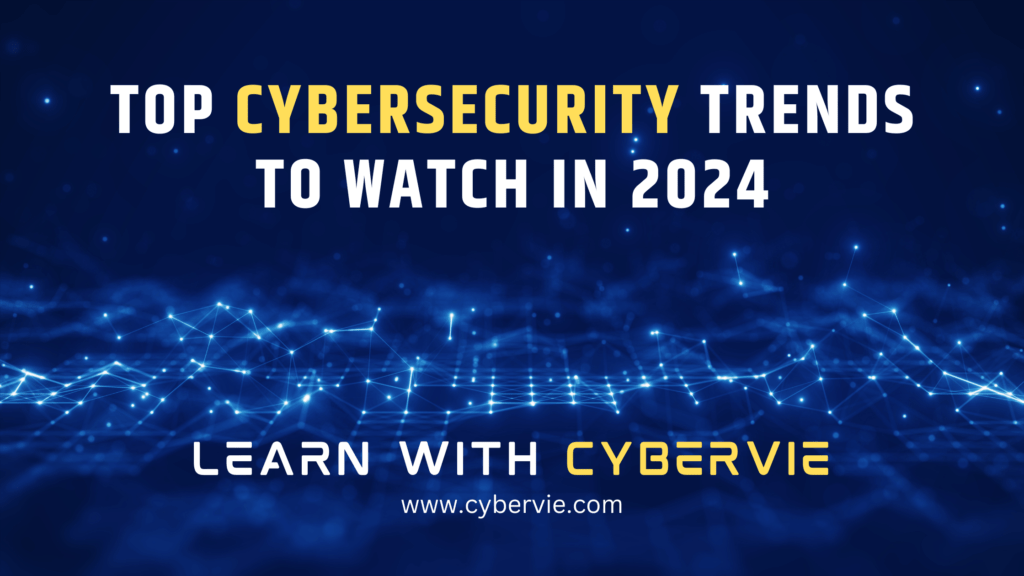Top Cybersecurity Trends to Watch in 2024
In this article, we’ll delve into the Top Cybersecurity Trends to Watch in 2024 that are expected to shape the cyber landscape. Whether you’re a cybersecurity professional, a business leader, or simply someone keen on keeping your digital life secure, these trends are crucial to keep an eye on.
As we move closer to 2024, the digital landscape continues to evolve at a breakneck pace. With this rapid advancement comes an array of sophisticated cyber threats that organizations and individuals must stay vigilant against. Staying ahead of the curve in cybersecurity is not just advisable—it’s imperative.
Emerging Cybersecurity Threats
As technology integrates deeper into our lives, the potential attack surface for cybercriminals expands. Here are a few emerging threats that we need to prepare for.
1. Rise of AI and Machine Learning in Cybersecurity
Artificial Intelligence (AI) and Machine Learning (ML) are transforming cybersecurity. Artificial Intelligence (AI) is a double-edged sword. While it has the potential to bolster our cyber defense mechanisms, it also gives cybercriminals the tools to launch more sophisticated and targeted attacks. In 2024, we can expect to see AI-driven phishing attempts, malware, and ransomware that can learn and adapt to security measures in real-time.
- Threat Detection: AI and ML algorithms can identify patterns and anomalies in network traffic, flagging potential threats faster than traditional methods.
- Automated Response: These technologies can automatically respond to threats, reducing the time between detection and mitigation.
- Predictive Analysis: AI-driven predictive analysis helps in forecasting potential vulnerabilities and attacks, allowing proactive measures.
2. Increased Focus on Zero Trust Architecture
The Zero Trust model is becoming a cornerstone of modern cybersecurity strategies. It operates on the principle of “never trust, always verify,” requiring strict verification for anyone trying to access resources.
- Continuous Verification: Every user and device must be authenticated, authorized, and continuously validated for security configuration before gaining access.
- Micro-Segmentation: This approach divides networks into smaller segments, limiting the potential impact of a breach.
- Least Privilege Access: Users are given the minimum levels of access necessary, reducing the risk of insider threats.
3. Privacy-enhancing technologies (PETs)
With growing concerns over privacy, the adoption of Privacy-Enhancing Technologies will increase. These technologies aim to protect users’ personal information while still allowing data to be used and shared for legitimate purposes.

4. Expansion of Cloud Security
With more businesses migrating to the cloud, ensuring the security of cloud-based assets is paramount. Cloud security strategies must evolve to address new threats.
- Shared Responsibility Model: Understanding the division of security responsibilities between cloud service providers and customers is critical.
- Data Encryption: Encrypting data both in transit and at rest in the cloud protects against unauthorized access.
- Access Management: Implementing strong identity and access management controls to safeguard cloud environments.
5. Enhanced Focus on IoT Security
The Internet of Things (IoT) has brought about a new era of connectivity. However, many IoT devices are notoriously lacking in robust security features. As more devices connect to the internet, expect a rise in attacks that exploit these vulnerabilities to gain access to larger networks.
6. Evolution of Ransomware Tactics
Ransomware attacks are becoming more sophisticated, targeting larger organizations and demanding higher ransoms.
- Double Extortion: Attackers not only encrypt data but also threaten to release sensitive information if ransoms are not paid.
- Ransomware-as-a-Service (RaaS): This model allows even less technically skilled criminals to launch attacks using tools developed by others.
- Preventative Measures: Regular backups, employee training, and robust security measures are essential to prevent ransomware attacks.
7. Regulatory Compliance Tightens
We can expect to see tighter regulatory compliance standards, especially with the growing adoption of General Data Protection Regulation (GDPR) principles worldwide. Organizations will need to pay close attention to evolving regulations to avoid hefty fines and reputational damage.
- GDPR and CCPA: Regulations like the General Data Protection Regulation (GDPR) and the California Consumer Privacy Act (CCPA) impose heavy fines for non-compliance.
- Data Breach Notification: Organizations must quickly notify affected individuals and authorities in the event of a data breach.
- Privacy by Design: Incorporating privacy measures into the design of systems and processes from the outset.
8. Deepfakes and Disinformation
The ability to create convincing fake audio and video content, known as deep fakes, is becoming more accessible. This trend could have severe implications for cybersecurity, as deepfakes can be used for social engineering attacks to deceive individuals and manipulate public opinion.

9. Increasing Supply Chain Attacks
Attacks targeting supply chains can have widespread impacts, affecting multiple organizations through a single vulnerability.
- Third-Party Risk Management: Evaluating and managing the security practices of third-party vendors.
- Supply Chain Transparency: Gaining visibility into the entire supply chain to identify and address vulnerabilities.
- Regular Audits: Conducting regular security audits of suppliers and partners.
10. Cybersecurity Skills Gap
The shortage of skilled cybersecurity professionals continues to be a significant challenge.
- Training and Education: Investing in training programs to develop the next generation of cybersecurity experts.
- Certification Programs: Encouraging certifications like CISSP, CEH, and others to ensure a qualified workforce.
- Diversity and Inclusion: Promoting diversity in cybersecurity to bring varied perspectives and solutions.
Ready to take your Cybersecurity skills to the next level?
Join our CSEP – Certified Security Engineer Professional – Advanced Training Program on Cybersecurity
Click Here to Enroll CSEP Advanced Training Program
The top cybersecurity trends to watch in 2024 reflect the ongoing cat-and-mouse game between cyber defenders and attackers. As attackers grow more sophisticated, so must our defenses. By staying informed about these trends and investing in the right technologies and training, we can hope to not just survive but thrive in the face of these challenges.
Remember, cybersecurity is not a destination but a journey. It requires constant vigilance, innovation, and adaptation. As we look toward 2024, let’s commit to staying one step ahead in this ever-evolving battle for cyber safety.
For More Related Blog Contents – Click Here









